The files available here have
been found on the web and the first one, "box
simulation and room-gain", is an easy
quick-and-dirty file that tells us what's going on.
The second file, SpeakerBoxDesigner, is found at an
excellent Dutch website:
http://www.mh-audio.nl/sql7/ViewDownloadFiles.asp
Both files in this zip file:
Download.
Tutorials
Download
"box simulation and room-gain" excel file for
ScanSpeak 18W/8531-G00
here, and you will
find this:
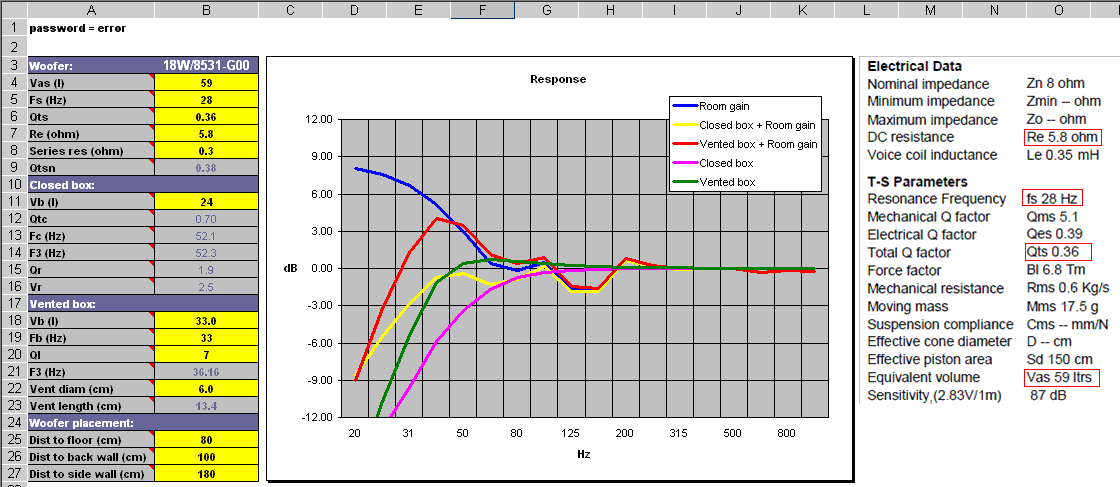
From
manufacturer's data sheet you get the TS data and you
only need four values to get going, Fs, Re, Vas and Qt.
Insert resistance of
the coil(s) in series with the bass driver in cell B8,
something like 0.2-0.4 ohms. It doesn't make a huge
difference.
This
file does not tell you optimum cab volume for a given
driver and we may question whether this is desirable at
all as only a few drivers will
fit in nicely when it comes to the math. For ported
systems, only drivers with a Qt close to 0.35 will make a
perfect match.
Dealing with high-Qt drivers (e.g. Qt > 0.4) we use
cabs too small and for low-Qt drivers (e.g. Qt < 0.3)
we tend to use too large cabinets.
Remember, there's no "right" here. You can use
whatever you want, but be aware of the consequences of
what you're doing.
Too small cabs may mean no bass and too large cabs may
produce a boom-box with un-precise bass performance (e.g.
2.5 clone).
Closed
system:
Try a cabinet volume making Qtc = 0.7 and see
what happens. In this case we reach 24 liters and this is
not too far off. Try inserting 30 liters (change cell
B11)
and you find the response (purple curve) reaching a bit
lower. What you also see from the graphs is that the
closed box will make much less bass at 40 Hz com-
pared to the vented system. If you're not a bass freak,
you may prefer the short and dry bass coming from the
closed box compared to the more voluminous bass
from the ported system. I often recommend making the
ported system and you can always stuff the vent with a
sock if the bass becomes too boomy. If you ad a
minor amount for e.g. dacron/acoustilus/MDM3 to the port
you're having an aperiodic system and this may not be bad
at all. Try it out!
Ported
system:
The 18W drivers are mostly seen in 28-33 liter ported
cabs and we have a nice (almost) flat response down to 40
Hz. Only a minor increase of ~1 dB in
the 60-100 Hz range. No problem. We're ~5 dB down at 30
Hz and this is not a common view I can tell. This driver
goes deep from a 33 liter vented cab.
The price to pay for this is efficiency on the low side.
The
port: Insert your port diameter in cell B22 and
you can read the port length in cell B23 and you don't
have to be nit-picking on this value. Anything from 13-14
cm
length will do perfect. If you have a slightly conical
port, use diameter at outlet (and not maximum diameter of
a flared port).
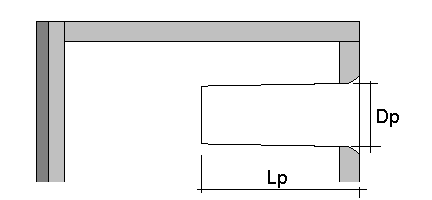
Do not
feel tempted to make a 50 liter ported system for this
driver if you find you can get -3dB @ 30 Hz and think
YES, this is what I want. There's a price to pay for
this in terms of a boomy and un-precise bass performance.
You may ask what the heck is the optimum size
cab for this driver? Hmm.... read on.
SpeakerBoxDesigner:
Download
Speaker-Box-Designer for 18W/8531-G00
here, and you will
see this:
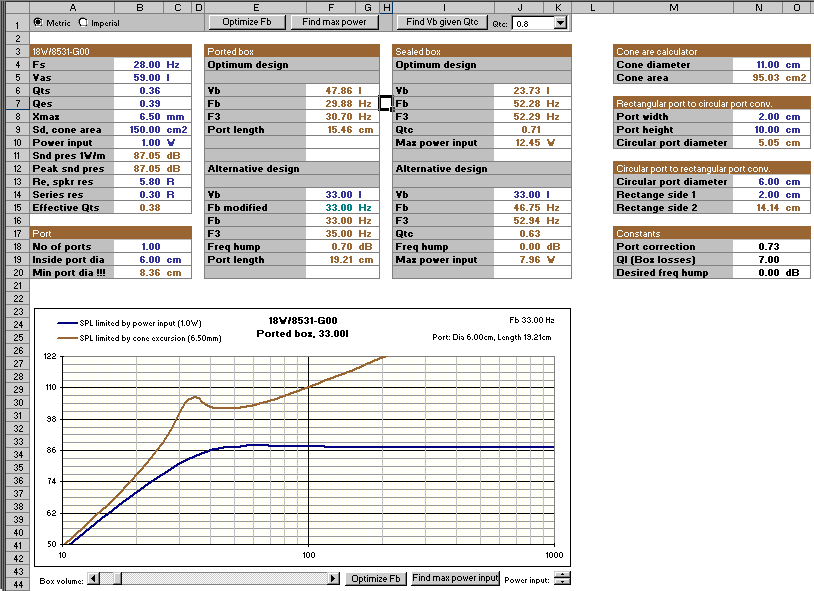
I don't have a password for this file, but we
can view the formulas used for calculation. The port
length is not corrected to fit reality and if you use
this file, multiply port length by 0.7.
This is
a more sophisticated program telling you optimum cabinets
based on TS parametres.
You need to add more data (cells with blue font) and we
read a recommended closed box of 24 liters and a calc.
ported box of 48 liters, making F3 = 31 Hz!
Now, we
would never place the 18W driver in a 48 liter vented
box. Or, it would be like making a modern 2.5-clone
getting deep, deep
bass although boomy, sloggish, one-note, etc. Not a good
choice.
So, how
do we really decide which volume we should use for a
given driver? Only practice can tell. We need to try out
the driver in various volumes,
experiment with various Fb and we need to listen. We also
need to listen to the midrange in case we making a 2-way
with the 18W handling anything from
the lower bass to 2.5-3 kHz. I've tried the 18W in 22
liter volume and I didn't like the midrange being flat
with too much presence. The 18W as midrange in a
3-way system is another story, here 22 liters do really
well.
What
makes the whole thing even worse is that manufacturers'
TS data may not always be right. Sometimes even very much
wrong, so we have to
measure TS data ourselves and see if this makes a more
likely scenario. There's no international standard for
measuring TS data, so the results will vary
enormously depending on the voltage applied during
measurements. Speakers are highly un-linear devices.
So, I
use the manufacturers' data and I use my own data. Next I
model the driver in LspCAD to see if this driver is
really possible! In LspCAD you can fiddle
with all driver parametres and make cross-calculation to
see it what we measure makes sense and not least if what
the manufacturer claim is really plausible.
Here you can also explore more ported tunings like
SBB4/BB4, QB3/SQB3 and SC4/S4.
An SBB4 tuning will typically use a large box with a low
tuning with a more shallow rool-off and extended at the
low-end.
QB3 uses a smaller cab and a high tuning resulting in a
flatter response and a steeper roll-off profile.
SC4 uses a sligtly larger cabinet compared to the QB3
with a fairly low tuning, not too different from the SBB4
tuning.
Here's
the LspCAD results based on SS data:
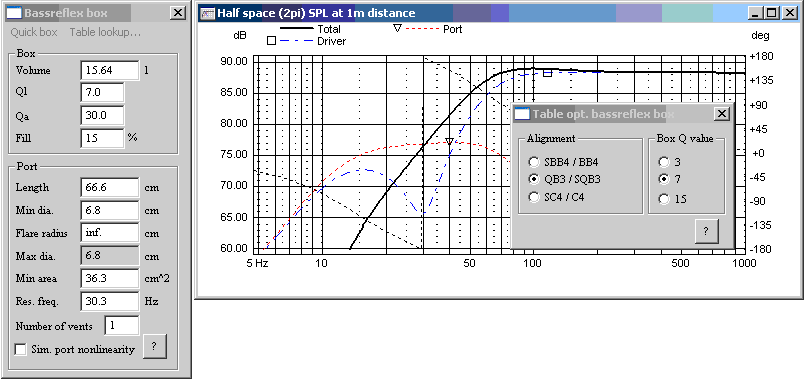
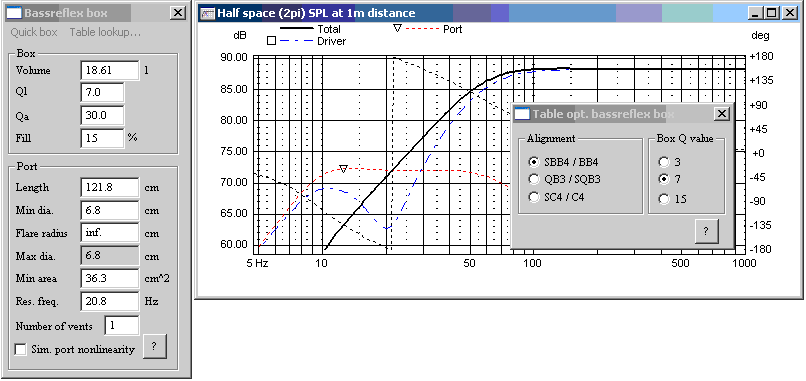
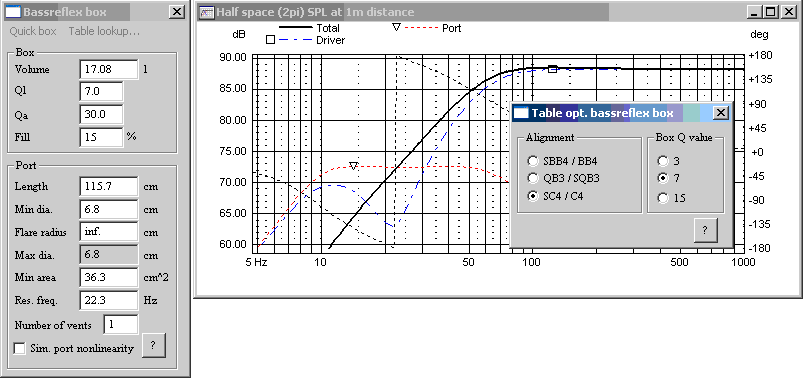
QB3,
SBB4 and SC4 all prescribes boxes of 15-20 liter volume!
Here's
what we usually do: 33 liter and a port tuning of 30-33
Hz. Confused? No wonder!
Considering the impact of damping material on virtual
volume as shown below, I'd make a 28 liter cab for the
18W reaching a virtual volume of 32-34 liter
when properly damped.
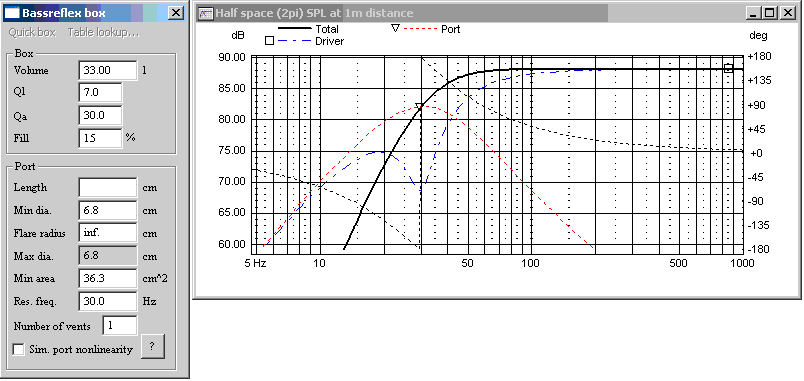
The
impact of damping materials on box volume
Adding
damping materials to a recent construction I started
wondering if the dense green felt I often use really
doesn't reduce box volume rather than increase box
volume.
So, time for a small study:
Materials:
test cab, 33.4 liter net volume,
internal dimensions 460 x 280 x 260 mm (volume of two
fillets for mounting front panels subtracted)
Driver: ScanSpeak 21W/8555-01, Fs = 17 Hz, Vas =
169.5 liter
Green felt, approx. 10 mm thickness.
Egg crate foam, 30 mm
Monacor MDM3, 33% polyester foam and 67% sheep's wool.
To cover
internal walls with 0.5 m^2 of damping materials were
used.
Results:

- As can
been seen the green felt did not reduce volume, rather
increased virtual volume by 6%.
- For egg crate foam and MDM3 we see an increase in
virtual box volume of around 15%.
As
always: Take into account the impact of damping matrials
on your box volume.
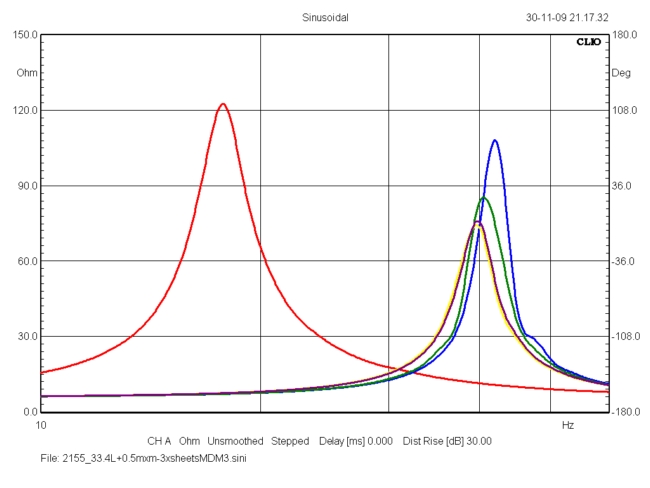
Red = unit in free air, empty box (blue), green felt
(green), egg crate foam (brown) and MDM3 (yellow).
|
